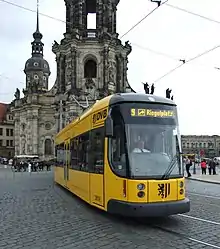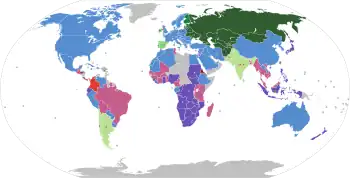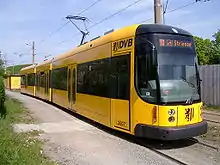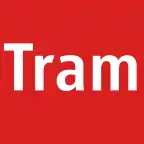Trams in Dresden
The Dresden tramway network (German: Straßenbahnnetz Dresden) is a network of tramways forming the backbone of the public transport system in Dresden, a city in the federal state of Saxony, Germany. Opened in 1872, it has been operated since 1993 by Dresdner Verkehrsbetriebe (DVB), and is integrated in the Verkehrsverbund Oberelbe (VVO).
| Dresden tramway network | |||||||||||||||||||
|---|---|---|---|---|---|---|---|---|---|---|---|---|---|---|---|---|---|---|---|
 A tram in front of the Dresden Cathedral, 2008. | |||||||||||||||||||
| Operation | |||||||||||||||||||
| Locale | Dresden, Saxony, Germany | ||||||||||||||||||
| |||||||||||||||||||
| |||||||||||||||||||
As of 2008, the network comprised 12 tram lines,[1] with a total line length of approximately 210 kilometres (130 mi)[1] and a total route length of 132.7 kilometres (82.5 mi).[2] There was 291.6 kilometres (181.2 mi) of track,[2] which translated into 132.7 kilometres (82.5 mi) of actual tram line,[2] serving 154 tram stops.[2]
History
The origins of the Dresden tramway network can be traced back to the year 1872,[3] when the first horse-drawn line opened between the city centre and the former village of Blasewitz, now a borough of Dresden.
Lines

| By transport mode | ||||||||||||||||||||||||||||||||||||||||||||||||||||||||||||||||||||||||||||||||||||||||||||||||||||||||||||||||
|---|---|---|---|---|---|---|---|---|---|---|---|---|---|---|---|---|---|---|---|---|---|---|---|---|---|---|---|---|---|---|---|---|---|---|---|---|---|---|---|---|---|---|---|---|---|---|---|---|---|---|---|---|---|---|---|---|---|---|---|---|---|---|---|---|---|---|---|---|---|---|---|---|---|---|---|---|---|---|---|---|---|---|---|---|---|---|---|---|---|---|---|---|---|---|---|---|---|---|---|---|---|---|---|---|---|---|---|---|---|---|---|---|
| By size (list) | ||||||||||||||||||||||||||||||||||||||||||||||||||||||||||||||||||||||||||||||||||||||||||||||||||||||||||||||||
| ||||||||||||||||||||||||||||||||||||||||||||||||||||||||||||||||||||||||||||||||||||||||||||||||||||||||||||||||
| Change of gauge | ||||||||||||||||||||||||||||||||||||||||||||||||||||||||||||||||||||||||||||||||||||||||||||||||||||||||||||||||
| By location | ||||||||||||||||||||||||||||||||||||||||||||||||||||||||||||||||||||||||||||||||||||||||||||||||||||||||||||||||
 | ||||||||||||||||||||||||||||||||||||||||||||||||||||||||||||||||||||||||||||||||||||||||||||||||||||||||||||||||
The Dresden tramway network is a mixed system of traditional street running, especially in the inner city boroughs close to the city centre, and modern light rail. The network uses the unique gauge of 1,450 mm (4 ft 9+3⁄32 in), which is just 15 mm or 19⁄32 inch wider than 1,435 mm (4 ft 8+1⁄2 in) standard gauge.[4] This gauge is sometimes called the Dresden Gauge.
In recent years, street running has been replaced by independent right-of-way arrangements wherever possible, and new extensions created in the same form. In November 2008, a 2.8-kilometre (1.7 mi) extension of line 7 was opened from Gorbitz to Pennrich, in Dresden's south eastern suburbs. In May 2011, a 1.6-kilometre (0.99 mi) extension of line 10 opened from Friedrichstrasse to the city's Messe or exhibition centre, involving construction of a 315-metre (1,033 ft 6 in) long, 15-metre (49 ft 3 in) wide and 5.4-metre (17 ft 9 in) high bridge across the floodplain of the River Elbe.[5][6][7][8] In July 2019, routes 9 and 13 were realigned along a 1.1-kilometre (0.68 mi) section to provide better connections with regional trains at Dresden-Strehlen station.[9]
Unlike various other German cities of comparable size, no stadtbahn style tunnel sections or high platform stops have been created. Many tram stops have been rebuilt so as to be fully accessible to physically disabled persons, and to allow level boarding to the newer low floor trams that now operate most services.
Different lines can be identified by a line number and a colour code. As of 2017 the lines are:[10]
| Line | Route | Length | Time | Stops |
|---|---|---|---|---|
| 1 | Prohlis – Gruna – Straßburger Platz – Postplatz – Bahnhof Mitte – Friedrichstadt – Leutewitz | 15.4 kilometres (9.6 mi) | 47 min | 34 |
| 2 | Kleinzschachwitz – Gruna – Straßburger Platz – Postplatz – Bahnhof Mitte – Cotta – Gorbitz | 18.2 kilometres (11.3 mi) | 55 min | 38 |
| 3 | Coschütz – Plauen – Hauptbahnhof – Pirnaischer Platz – Albertplatz – Bahnhof Neustadt – Trachenberge – Wilder Mann | 11.9 kilometres (7.4 mi) | 38 min | 25 |
| 4 | Laubegast – Striesen – Straßburger Platz – Postplatz – Mickten – Radebeul – Coswig – Weinböhla | 28.9 kilometres (18.0 mi) | 79 min | 56/57 |
| 6 | Niedersedlitz – Blasewitz – Albertplatz – Bahnhof Neustadt – Bahnhof Mitte – Löbtau – Wölfnitz (– Gorbitz) | 22.0 kilometres (13.7 mi) | 67 min | 44/45 (48/49) |
| 7 | Pennrich – Gorbitz – Löbtau – Hauptbahnhof – Pirnaischer Platz – Albertplatz – Klotzsche – Weixdorf | 23.2 kilometres (14.4 mi) | 63 min | 43/44 |
| 8 | Südvorstadt – Hauptbahnhof – Postplatz – Albertplatz – Hellerau | 13.4 kilometres (8.3 mi) | 40 min | 27 |
| 9 | Prohlis – Strehlen – Zoo – Hauptbahnhof – Postplatz – Mickten – Kaditz | 17.0 kilometres (10.6 mi) | 51 min | 40 |
| 10 | Striesen – Straßburger Platz – Hauptbahnhof – Bahnhof Mitte – Vorwerkstraße (Friedrichstadt) – Messe Dresden | 11 kilometres (6.8 mi) | 36 min | 23 |
| 11 | Zschertnitz – Hauptbahnhof – Postplatz – Bahnhof Neustadt – Albertplatz – Weißer Hirsch – Bühlau | 15.9 kilometres (9.9 mi) | 48 min | 31 |
| 12 | Striesen – Blasewitz – Straßburger Platz – Postplatz – Löbtau – Cotta – Leutewitz | 14.5 kilometres (9.0 mi) | 49 min | 32/33 |
| 13 | Prohlis – Strehlen – Zoo – Straßburger Platz – Neustadt – Pieschen – Mickten (– Kaditz) | 14.7 kilometres (9.1 mi) | 48 min | 37 (43) |
| 20 | Messe Dresden – Maxstraße – Postplatz – Webergasse | 12 min |
Future plans, as part of the Stadtbahnprogramm 2020, include 14.9 kilometres (9.3 mi) of new tram line, with work starting in 2014. Some 10.5 kilometres (6.5 mi) would be on reserved track, and the new lines would replace bus lines 61 and 62, some of the city's busiest, with an estimated cost of 223 million euros. The new lines comprise:[11]
- Prager Str to Plauen Bhf via Budapester Str and Chemnitzer Str
- Großer Garten to Löbtau via Technische Universität
- City Center to Fetscherplatz via Pillnitzer Str and Striesener Str
- Sachsenallee to Max-Planck-Institute via Johannstadt
- Bühlau to Weißig
On all tram lines except lines 4 and 11, a general 10-minute headway is offered on weekdays, extending to 15 minutes on Saturday, Sunday and in the evening. On the main routes through the inner city, where different lines intertwine, vehicles run up to every two minutes. Line 4, which extends a considerable distance beyond the city boundary to the towns of Radebeul, Coswig and Weinböhla, operates the standard 10 or 15 minute interval service as far as Radebeul West, and a 30-minute service beyond that to Coswig and Weinböhla.[12] Line 11 is running every 7 to 8 minutes during peak hours.
Rolling stock

As of 2008, Dresden's tram fleet was made up of 166 modern tramsets (with 31 older trams).[13] Most of the trams operating in Dresden are articulated low floor cars, of two different basic designs, each of which has several variants.
The first generation of low floor cars was built by Deutsche Waggonbau in Bautzen between 1995 and 2002; both 6 and 8 axle variants exist. The second generation of low floor cars have been built since 2003 are Bombardier Flexity Classics, both 8 and 12 axle variants exist. The articulated cars vary in length from 30 to 45 metres (98 ft 5 in to 147 ft 8 in) long; all run as single car sets.[13]

The fleet used to be composed of ČKD Tatra trams that provided service towards the end of the GDR era. At present some Tatra T4 cars built between 1968 and 1984 are still in service, but it is intended that they will all be replaced by 2010. The Tatra cars are all high floor, precluding level boarding from tram stops, and run in two car sets with a set length of some 30 metres (98 ft).[13][14]
The DVB tram fleet operates out of three depots; at Gorbitz on routes 2,6 and 7 in south west Dresden, at Trachenberge on route 3 in the north-west, and Reick on routes 1, 9 and 13 in the south-east. Gorbitz is new facility opened in 1996 and includes a new central workshops. Trachenberge and Reick are older facilities that have both been heavily rebuilt to similar standards, whilst several other older depots have been closed. The former central workshops at Trachenberge, adjacent to the current depot, now house the Dresden Tram Museum, which has a collection including examples of many former Dresden trams.[5][15]
CarGoTram

The CarGoTram was a freight carrying tram that supplied Volkswagen's Transparent Factory, crossing the city. The two trams, up to 60 metres (200 ft) long, was the longest vehicles allowed to use roads in Dresden. The connection by tram was established to reduce the number of trucks used. The factory is located to the east of the city centre, next to the Großer Garten, whilst the distribution depot that loads the parts is to the west of the city centre.[16]
References
Notes
- "Zahlen & Daten" [Numbers & Data] (in German). DVB. Retrieved 2013-09-14.
- "Zahlen & Daten 2009" [Numbers & Data 2009] (PDF) (in German). DVB. Retrieved 2013-10-30.
- "Die Geschichte der DVB AG" [The History of DVB AG] (in German). DVB. Retrieved 2013-09-14.
- "World Systems List of LRT, Tramways and Metros - F-J". Light Rail Transit Association. Retrieved 2009-03-24.
- Streeter, Tony (April 2008). "Dresden trams heading west". Tramways & Urban Transit. Ian Allan Ltd / Light Rail Transit Association. pp. 133–136.
- "Urban rail news in brief - October 2010". Railway Gazette International. 2010-10-03. Retrieved 2010-10-05.
- "Dresden Messe tram extension opens". Railway Gazette International. 2011-06-02.
- "Dresden Messebahn opened". Today's Railways. Platform 5 Publishing Ltd. July 2011. p. 16.
- "Dresdner Verkehrsbetriebe weihen neu gebaute Bahnstrecke ein" (in German). MDR Sachsen. 2019-07-05. Retrieved 2019-08-07.
- "Liniennetz" (in German). DVB. Retrieved 2009-04-18.
- "Dresden unveils tramway expansion". Tramways & Urban Transit. Ian Allan Ltd / Light Rail Transit Association. May 2011. p. 165.
- "Fahrplanbuchseite" (in German). DVB. Retrieved 2009-03-16.
- "Zahlen & Daten - Straßenbahnflotte" [Numbers & Data - Tram Fleet] (in German). DVB. Retrieved 2013-10-30.
- "Trams & Buses". City of Dresden. Retrieved 2009-03-10.
- "Strassenbahnmuseum Dresden e.v." (in German). Strassenbahnmuseum Dresden e.v. Retrieved 2009-03-23.
- "CarGoTram Dresden" (in German). DVB. Retrieved 2009-03-03.
Bibliography
- Bauer, Gerhard; Kuschinski, Norbert (1993). Die Straßenbahnen in Ostdeutschland [The Tramways in East Germany]. Vol. Band 1: Sachsen [Volume 1: Saxony]. Aachen, Germany: Schweers + Wall. ISBN 3921679796. (in German)
- Schwandl, Robert (2012). Schwandl's Tram Atlas Deutschland (in German and English) (3rd ed.). Berlin: Robert Schwandl Verlag. pp. 40–43. ISBN 9783936573336.
External links
![]() Media related to Trams in Dresden at Wikimedia Commons
Media related to Trams in Dresden at Wikimedia Commons
- Dresdner Verkehrsbetriebe – official site (in English)
- Dresden database / photo gallery and Dresden tram list at Urban Electric Transit – in various languages, including English.
- Dresden database / photo gallery at Phototrans – in various languages, including English.



